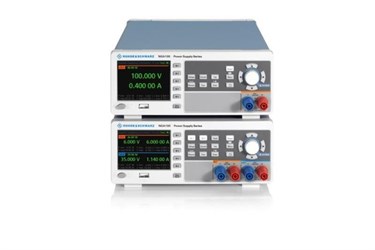R&S NGA100 delivers linear accuracy to basic power supply class
R&S NGA100 delivers linear accuracy to basic power supply class

Rohde & Schwarz has expanded its range of basic power supplies with the new R&S NGA100 series.
The NGA100 is available in four models, providing a choice of single and dual outputs with up to 35 V/6 A per output, or 100 V/2 A per output. Single output models supply up to 40 W, dual output models up to 80 W power. The dual model outputs can be combined to provide up to 200 V or 12 A.
Rohde & Schwarz said that it has implemented a linear design throughout the output circuits of the NGA100 which significantly improves performance compared to the switched-mode circuits frequently found in basic power supplies. As a consequence. the higher accuracy means engineers will be able to supply exactly the right power level without any need for an additional multimeter.
The standard level of readback resolution, 1 mV/100 µA, is enhanced for currents under 200 mA to a resolution of 1 µA, making it easier to test the low current levels that are typical for IoT applications in standby and sleep mode. The NGA100 also has the necessary dynamic range for power and current spikes when switched to active mode.
Many basic power supplies only output maximum power within a very limited voltage/amperage range, the FlexPower technology from Rohde & Schwarz, however, is able to provide maximum power for a wide range of combinations, so that a single instrument can support many different applications.
Users also benefit from an intuitive user interface, and features like instantaneous statistical functions for maximum and minimum values for power, voltage and current, displayed directly on the screen.
Other features of the NGA100 not commonly found in a basic power supply include logging voltage and current values for analysis, with up to 10 samples per second. For data export and remote control, Ethernet and USB are supported as standard, with optional WLAN and an external trigger with digital I/Os. Users can generate sequences of voltage/current settings at intervals down to 10 ms.
The supplied power is low distortion and low noise, and cable losses can be compensated thanks to a remote sensing function. The correct level is at the input to the device under test, not at the output of the power supply.